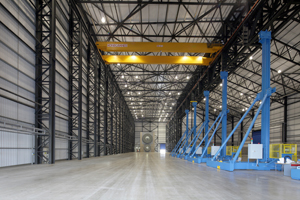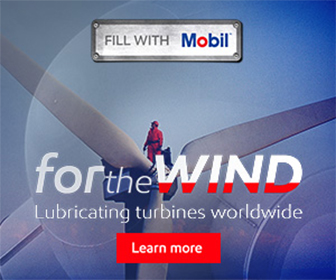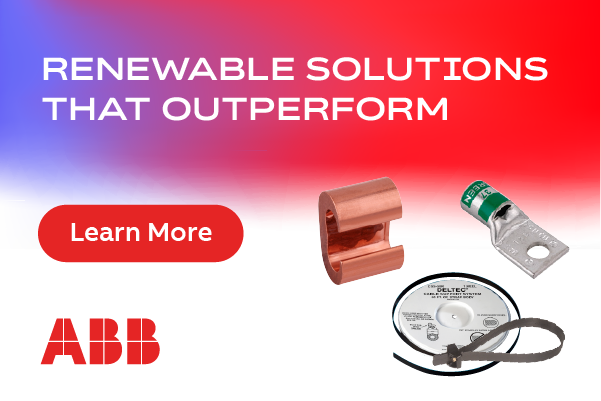Testing for Size: When larger turbine blades mean greater strength
 The titleholder of “the world’s largest blade testing facility” has changed hands again. It’s all right if you weren’t keeping track. The honor isn’t nearly as important as the trend it signifies: larger test facilities signal the coming of larger blades.
The titleholder of “the world’s largest blade testing facility” has changed hands again. It’s all right if you weren’t keeping track. The honor isn’t nearly as important as the trend it signifies: larger test facilities signal the coming of larger blades.
The record-holding test facility is at the UK-based National Renewable Energy Centre (Narec). The 5,700m2 reinforced building is 123 meters long, with a 74-meter unsupported structured span, housing a 15-meter concrete superstructure test hub. The UK government established Narec in 2003, and funding comes from the private sector, British government, and the European Union. According to its website, Narec advances the development, demonstration, and deployment of offshore renewable energy technologies. Along with verifying development work, one of the primary reasons clients use Narec is that the facility’s accredited test reports form part of a blade maker’s certification.
The organizations’ latest facility in Blyth, Northumberland, can test blades of up to 100 meters in length. Prior to Narec’s 100-meter, blade-testing facility opening its doors, the world’s largest blade test facilities were the Wind Technology Testing Center in Boston and the Fraunhofer Institute for Wind Energy and Energy System Technology (IWES) in Germany. The WTTC and IWES sites can test blades up to 90 meters long. For a sense of just how far the industry has come, consider Siemens’ first generation wind turbine built 30 years ago—it had blades measuring a mere five meters.
Why longer blades?
Narec operates a 50-meter, blade-testing facility, too. But, the 100-meter facility was sought out by manufacturers because larger wind turbine blades have grown economically feasible. Since wind’s potential energy is directly proportional to the cube of the wind speed, even a boost in wind speed of just a few miles per hour yields far more electricity—in some cases 50% more.
Moving a wind turbine offshore means generally faster winds, which aren’t slowed by the friction of ground and vegetation. Plus, at higher altitudes, the wind’s power is greater. Longer blades placed offshore typically harvest significantly more electricity. But, ensuring blades stand up to offshore winds involves testing, of course.
Blade testing by the numbers
To vet a blade’s design, test facilities conduct static and fatigue-blade testing. A typical test program can take over a year to complete, and the current industry norm for these tests requires at least one million cycles in both directions, roughly simulating what a wind turbine would experience during 20 years of operation.
Complementing the fatigue tests are static tests, which last for several weeks. Static tests also put pre-determined loads, arriving from different directions, on the blade. The intent is to put up to 150% of a blade’s rated load against the test specimen to calculate its stiffness and strength.
Manufacturers rely on blade tests to determine, among other things, if they can reduce some of the material used to construct blades. Less material can mean lower manufacturing costs. Costs can add up, especially when manufacturers are producing tens of thousands of blades annually. In 2007, it’s estimated that wind turbine manufacturers produced approximately 44,000 blades (according to www.compositesworld.com). Blades typically make up 15% to 20% of the purchase price of a wind turbine, and a three-megawatt (MW) blade is valued between $250,000 and $300,000.
Blade testing isn’t markedly different for offshore blade designs than it is for onshore ones. According to the American Wind Energy Association Third Quarter 2012 Market Report, the United States has 51,630 MW of installed wind power capacity, and more than 40,000 turbines, which are all onshore. The average blade length in the US is approximately 60 to 70 meters. Many of these blades are made by companies with blade-test facilities outside of the US.
But, America’s blade-testing capability is growing. For example, there are US-based turbine makers that have equipment for testing blade designs. And, according to the Department of Energy, the Boston-based WTTC, which is the first commercial large-blade test facility in the United States, could play a larger role in wind energy vis-à-vis testing.
Simulating the wind
Imagine taking a plastic bookmark, holding one end with your hand while bending the other with the tip of your finger. With the hub tower holding the wind turbine blade in position, Narec customers can set the wind turbine blade into resonance, or oscillation. The facility’s concrete hub tower has two mounting places for blades, one above the other.
Manufacturers and researchers can also perform resonance testing with a set of servo hydraulic actuators, strapped at intervals, along the length of the blade. The actuators are synchronized, and run by a computerized control system. The control system makes use of a multi-channel, closed-loop to dictate the degree of oscillation and force. Engineers will use the control system to regulate the amplitude and frequency of stress placed on a blade.
Ultimately, reliable blade testing is what helps manufacturers build a better blade. By testing construction and composition—ranging from glass fiber to thermoset resins—manufacturers can vet which design efficiently and economically withstands the cyclic forces acting on the blade. Inside a blade, the construction can range from I-beams to spars to box beams. What’s inside a manufacturer’s blade, though, is a closely guarded secret that Narec and other test facilities will continue to keep confidential. It’s no secret, however, that test facilities are preparing for blade manufacturers to go to greater lengths to harness the wind.
Mauro Gnecco is the North American Energy & Wind Market manager for Moog. Moog designs and manufactures high-performance motion control solutions, combining electric, hydraulic, and hybrid technologies for a range of applications.
Moog
www.moog.com
Author: Mauro Gnecco
Volume: January/February 2013









